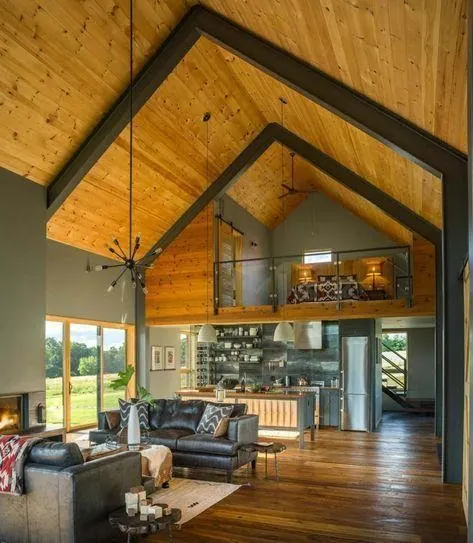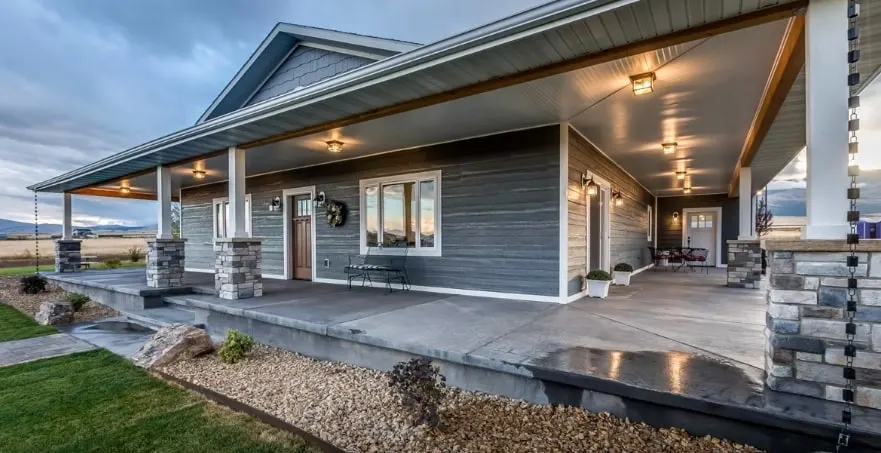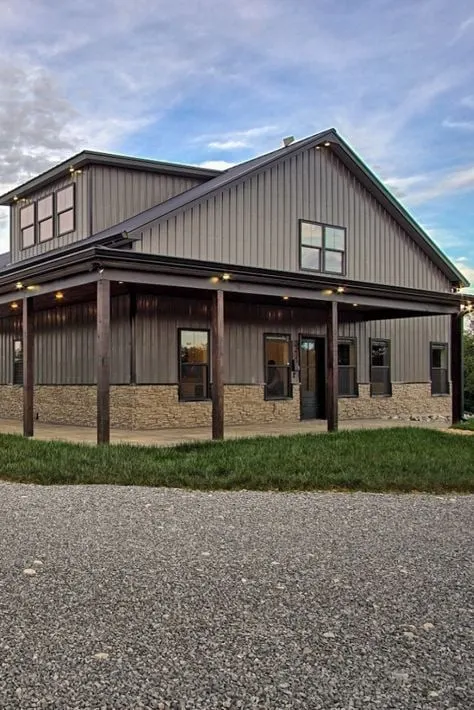Building a home is one of the most exciting endeavors you can undertake. Getting to design a home exactly how you want it with everything you need is an incredibly appealing prospect. You spend so much time in your home, don’t you want it to be up to your exact standards?

The problem comes in when you learn just how much money, time, and stress it takes to build a custom home from scratch. There are so many things to consider and a lot of things that can potentially go wrong. That’s usually when the wind starts to get taken out of your sails and you decide it might not be for you.
Building a barndominium is a fantastic alternative to building a traditional home. There are a number of advantages and they can all add up to a much easier and accessible building experience. That’s why so many people are starting to think about the barndominium vs house question.
In this article, we have laid out some of the benefits of building a barndominium vs a traditional house. These include many practical differences that can be real deciding factors. By understanding some of the important distinctions and how they can make the whole process easier, you can make the right decision for yourself.
Page Contents
What is a Barndominium?
A barndominium is a home built from the structure of a metal pole barn or steel building. They usually look exactly like a traditional home but use different materials and are built using different techniques and methods. They are also usually built in more rural areas since they can be simultaneously used for agricultural purposes like farming and animal husbandry.
You can build a barndominium from a new structure or you can convert an existing pole barn into a home. Whether or not you choose to do this will depend on several factors, which we have laid out below. Many people like to start their custom home completely from scratch if at all possible.
A barndominium can be built from the ground up, but it can also be constructed using a prefabricated kit. Kits are a great way to ensure that you get everything you need in one convenient package that comes all at once. You don’t have to source materials or hardware and this can really streamline the whole process.

Since barndominiums look just like a traditional home, there is almost no end to the amount of customization you can do. Country-style or modern contemporary can all work with this simple structure and give you the house you have been dreaming of. Below, we have compared some aspects of building a barndominium vs house that can help you make your final decision.
Ease of Construction
One of the major differences between building a barndominium vs house is that a traditional house will usually take much longer to build. 2×4 wood framing is a fairly complicated process and can take many months or even years. This can put a damper on your plans and end up costing you a lot more than you had initially planned.
Most metal pole barns can be put up in a matter of weeks instead of months. They have a simple construction process that leaves a lot less up to chance and can be bolted together much quicker. This makes the whole operation much easier.
One of the things people have trouble with when they are building their own home is how much time it takes to get construction underway. With a barndominium, you can begin construction as soon as your kit arrives or all the materials are gathered. This ease is one of the major pluses in the barndominium vs house debate.
The ease of the construction can also help ease some of the stress involved in building a home. Construction is a relatively difficult undertaking, especially for a major project like a house. The ease with which a metal pole barn can be built can help give you some peace of mind that you might not otherwise get with a traditional house build.
Price
Building a home is not only an intimidating undertaking, but it can also be an expensive one. The cost is one of the things that puts people off initially and can put a wrench in the works when planning your house. Luckily, in the barndominium vs house debate, barndominiums win this category in a big way.
When you are budgeting for a house build, you will want to plan it by the square foot. This method allows you to know exactly how much house you are going to need and plan out your floor plan. It will also allow you to get a good idea of how many bedrooms and bathrooms you can afford.
The price per square foot of a barndominium vs house varies by state. However, for the most part, a barndominium is going to cost much less per square foot. In some states, they can be almost half as much, which makes them much more accessible to people from all kinds of socioeconomic backgrounds.
On average, the cost to build a barndominium ranges from $95 to $125 per square foot, though this can fluctuate based on the complexity of the design, interior finishes, and current prices of materials. In contrast, the cost of building a traditional house can vary even more widely, typically running from $100 to $200 per square foot or more, depending on the region, materials, and level of customization. Traditional houses often involve more complex designs and a variety of materials such as brick, wood, or stone, which can increase both material and labor costs. Additionally, traditional construction may encounter more regulatory hurdles and inspections, potentially extending timelines and increasing costs.
However, it’s important to consider that the resale value and market demand for traditional homes can be higher in many areas compared to barndominiums, which are still gaining acceptance in the mainstream real estate market. Financing can also be more challenging to secure for a barndominium, as lenders may be less familiar with the concept compared to traditional homes, potentially affecting interest rates or loan availability. Ultimately, the decision between building a barndominium versus a traditional house should factor in not just the initial construction costs, but also long-term considerations such as maintenance, energy efficiency, resale value, and personal lifestyle preferences.
This lower cost is partially due to the ease of construction that we have discussed above. A shorter construction time means a cheaper cost of building. On top of that, the materials are less expensive and all of these factors start to add up over the course of your build.
Style
When you are considering the benefits of building a barndominium vs house, one thing you will want to consider is style. A traditional home is just that: traditional. A barndominium, on the other hand, is something truly unique and interesting, even if it has all the same trappings as a traditional house.
With the barndominium’s easy construction, you have a lot more freedom when it comes to customization. There is almost no limit to the additional features and extras that you can include in your barndominium’s floor plan and blueprints. After all, isn’t that the whole point of building your own custom home?
Durability
One of the major advantages of a barndo in the barndominium vs house debate is the fact that they have an all-steel construction. This makes them perfect for people who want to be sure that their home is durable and dependable in protection against the elements. Metal pole barns are meant to withstand a lot of abuse, and this makes them perfect for building a home out of.
Steel is a fantastic material to use for a home due to its ability to stand up to moisture. One of the major downsides of a traditionally built home is the wood construction. Wood is susceptible to rot and mold when it is exposed to a lot of water, which can lead to big problems down the line if you’re not careful.
If you are planning on building your home in an area that gets a lot of different weather, a barndo is definitely your best choice in the barndominium vs house question. They are built to stand up to a wide variety of wind, rain, ice, and snow. This makes them a great choice for rural living.

Maintenance
On top of their durability, barndominiums are also easy to clean and maintain. The steel construction makes it easy to simply hose them down when they get muddy or dirty. They also require less painting and upkeep than a traditional home with wood siding.
Because of their extra protection, there is less of a chance that water will get down into the structural areas and create hazards like mold and mildew. Having this extra protection will give you some peace of mind when the weather turns bad. It will also help save you money on large repairs and maintenance related to everyday wind and weather.
Conclusion
When considering your options when it comes to a barndominium vs house, knowing the facts can be a real help. Understanding just how a barndominium can be beneficial can help you decide if it’s the right choice for you. Your custom home should be tailored to your needs and expectations, and a barndo is a great way to check all those boxes.
Building a custom home is a challenge no matter what type you are looking to build. However, a barndominium has enough of an advantage to make it well worth your while. If you want the process to be as easy as possible, building a barndominium vs house is the way to go.
If you would like more guides like this one, check out the rest of BarndominiumLife.com. There, you will find more helpful tips and tricks from the pros. You will also find featured barndominiums, barndominium floor plans, and information on financing and insurance. Knowing as much as you can will help you get the best results for your dream home.
Michael O’Connor is a seasoned barndominium writer passionate about creating unique and innovative barndominiums. With over 15 years of experience in the construction industry, Michael has established himself as a leading expert in barndominium design and construction.
His work has been featured in several respected publications, including Barndominium Life, where he frequently contributes articles on best practices and emerging trends in the field. Michael’s ability to blend traditional techniques with cutting-edge technology and design concepts has earned him a reputation as one of the most knowledgeable writers in the industry.
